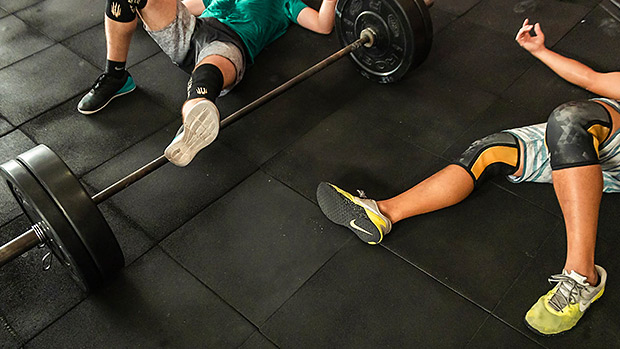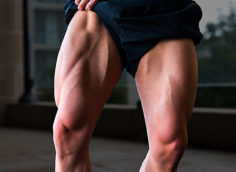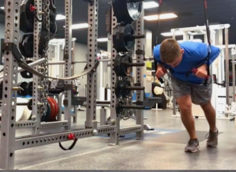The deadlift is the one exercise where someone can be pretty darn strong even without much muscle mass... if he or she has the right levers. I've seen skinny dudes with super-long arms and short torsos out-deadlift a 240-pound IFBB pro with short arms, a long torso, and poor mobility.
That's why tons of average lifters love the deadlift: It makes them feel strong. They might only bench press 205 pounds and squat 275, but they pull 405. These guys will post their videos all over Facebook and Instagram. And people will think, "Hey, if he can do it, so can I!" Gradually, the deadlift became a very popular ego lift.
The deadlift is certainly a good test of strength. It's also helpful to be good at picking things up from the floor. For competitive powerlifters, of course, it's mandatory. But it's an inferior exercise for building muscle. And for athletes, the deadlift from the floor has more cons than pros. I rarely have an athlete train the deadlift in the traditional manner.
In short, the deadlift isn't as great as most people think. Let's break it down.
The deadlift is the movement where everyone can lift the most weight. But that also makes it an inferior muscle-building tool. How does that make sense? If you lift more weight, shouldn't you be stimulating more growth?
The fact that you can move more weight is because you're involving more muscles as either prime movers or synergists. Once again, how's that a bad thing? Because the workload is divided over a lot more muscle groups. The muscles involved don't receive the same degree of individual stimulation, as in a squat for example.
You also don't stretch many muscles under load in a deadlift. This is likely the key point. If you do a full range squat or front squat, the quadriceps and glutes get fully stretched under load.
If you bench press, the pecs and anterior delts get fully stretched under load. If you use a close-grip variation, the triceps also get stretched under load. If you do a proper pull-up, the lats get fully stretched under load. You get the idea.
In a deadlift, only the traps get stretched, but they don't shorten. The hamstrings and glutes are somewhat stretched, but nowhere near their maximum.
Why is that important? Because having a muscle fiber lengthening while producing force/tension is one of the strongest growth stimuli. In the deadlift you lift a lot of weight because of optimal leverage. But because of the joint angles, no muscle receives optimal growth stimulation.
A Romanian deadlift (RDL) is much more effective at targeting the hamstrings and glutes.
It's a better hypertrophy tool because you're stretching those two muscles more fully. But to do that you must put your body in a "weaker" position (your leverages aren't as good). You're lifting less weight but you're building more muscle via better targeting with the RDL.
I'm not saying isolation work is better than multi-joint movements because you can better target a muscle. The overall load applied to the muscles is important. The optimal exercises allow you to put a large load on your muscles while ALSO stretching the muscles you're trying to develop.
The eccentric or negative phase of a lift is extremely important for muscle growth. If you get rid of the eccentric portion of the lift you'll get significantly less muscle growth.
Why? Because the main stimulus that triggers protein synthesis is lengthening the muscle fibers while they're resisting by producing tension. That happens during the eccentric/lowering phase of most exercises. The eccentric phase is also where most of the muscle damage (another stimulus) occurs.
Now look at the way most people deadlift. They don't control the eccentric. Some completely drop the bar after completion of the lift (very common among CrossFitters). Some actually accelerate on the way down to bounce the bar off of the floor to help them with the next rep.
Even among those who lower their deadlift somewhat under control, they do so with improper positions. They'll use more knee or torso bend rather that pushing the hips back (like in a RDL). By doing so, they don't place optimum loading on the targeted muscles – the hamstrings and glutes. It becomes mostly a lower-back exercise.
When I personally do deadlifts, or have my clients do deadlifts, a controlled eccentric tempo is always used. We do that by lowering it like an RDL (pushing the hips back) until the bar passes the knees. At that point, we bend the knees until the bar is on the floor.
This will lower the amount of weight you can lift because each set causes more fatigue in the muscles you're trying to develop (a good thing for growth) and because you can't use the bounce to get started. But from a muscle-growth perspective, it's more effective.
In the deadlift, you can move a lot of weight despite horrible form. You can look like a bent fishing rod and still make the lift.
Sure, hitting a PR isn't always textbook perfect, but some people deadlift with poor form even if they're not fatigued or using heavy loads. They do it all the time because they haven't learned to set up properly and use the right muscles.
They don't engage their lats at the start (imagine trying to break the bar and pinching a towel in your armpits) and they lift the bar straight up from the floor (instead of in a slight backward arc to engage the hamstrings and glutes). Both of these will leave the bar a bit forward and put most of the stress on the lower back.
They also don't create intra-abdominal pressure to stabilize the spine and hips. As a result, they not only put all the stress on the lower back, they do it while having bad spinal support. You will build your lower back, but not much else, by deadlifting like that. You also increase your risk of injury.
"Yeah, but I want a strong lower back!" Yes, you do. We should all have strong lower backs. But there are better, safer, and less draining ways to target it.
If you want to deadlift, do it with solid mechanics. Don't get lazy and "just rip it." You might still make the lift and move lots of weight, but you won't be building muscle optimally.
Body mechanics are what decide which muscles get stimulated the most. Improper mechanics on the deadlift will prevent you from stimulating the hamstrings and glutes.
If you decide to deadlift (which is fine, I do it myself), at least do it in a way to maximize your chances of getting growth out of it.
- Set up properly. Engage the lats at the start, contract your abs as if you were going to get punched in the stomach, and keep your hips back.
- Pull to emphasize the posterior chain. Initiate the pull in a "up and back" action, as if you were trying to bring your ass to the back wall. Do that while keeping the bar as close to you as possible – you'll need to keep those lats engaged.
- Control the eccentric. Lower the bar as if you were doing an RDL until the bar passes the knees, then bend the knees until the bar is on the floor.
- Don't bounce. Either reset on every rep or don't lower the bar all the way to the floor. Stop half an inch above the ground.
I don't use the deadlift from the floor with the athletes I train, except for powerlifters. Not because it's a bad exercise. When properly performed, there are no bad exercises, except curls on a BOSU ball.
No, I don't use the barbell deadlift from the floor because the benefits aren't worth the cost of the exercise... for an athlete.
An athlete has a more limited amount of "training money" to invest in the gym. That's because he also has to do speed and agility work, conditioning, and sometimes even sport-skill practices. So he can't do as much weight-training volume.
You must only choose exercises that will give you the most bang for your buck: the ones best suited to help you accomplish a certain goal.
You also need to consider the systemic effect of a movement. If an exercise is very draining on the nervous system or poses a higher injury risk, maybe it's not worth adding.
Let's look at the deadlift objectively. The benefits of the deadlift are developing the hamstrings, glutes, and lower back. It should be used to strengthen the hip hinge pattern. Side benefits will be improving your grip (if you don't use straps) and building the traps.
Developing the Hamstring and Glutes
We already saw that the RDL is a better option for that. And strictly from a muscular development standpoint, the reverse hyper, glute-ham raise, and good morning are better options too. (Lots of info here: The Best Damn Posterior Chain Exercises.)
Strengthening the Hip Hinge Pattern
It's easy to think that since the deadlift is the movement where you use the most weight on the hip hinge pattern, it will be great at improving hip hinge strength. And it is... if you do it properly.
However, most people don't. In that regard, the RDL is still a better option. It's a "purer" hip hinge.
Also, a lot of athletes lack the mobility to set up properly on a deadlift from the floor. This is especially true for bigger athletes. They'll often have to round their lower backs or bend their knees more to get into the proper position. The former (rounding the lower back) puts more load on the lower back and much less load on the hamstrings and glutes.
The latter shifts the work to the quads instead of the hamstrings. If you're squatting, this makes the movement redundant. In both cases, you end up not really training the hip hinge pattern.
The RDL, trap-bar deadlift, and pin pull from below the knees are all better heavy options for loading and strengthening the hip hinge pattern.
Strengthening the Grip
Sure, any exercise where you're holding weight can improve your grip. Since the deadlift uses a lot of weight, it can strengthen your grip the most, right? That's a great theory, but let's look at it closer.
If grip strength is a problem for you, it will be a limiting factor in your deadlift. If fact, if your grip is a limiting factor, you'll likely be able to use the same weight on an RDL.
People will point out that they use a mixed grip on the deadlift, and not on an RDL, so they can deadlift more. True. But the mixed grip doesn't increase grip strength to the same extent as a double-overhand grip. The mixed grip prevents bar rotation, which is the main reason why your hands open up. Yes, you're holding more weight, but you aren't strengthening the grip.
If your grip strength isn't a limiting factor on the deadlift, then you don't need to strengthen it that much as an athlete. (For a strongman competitor that's a different story.)
Unless you're a powerlifter, you should use straps (or a hook grip) when doing pulling work if your grip is a limiting factor. The main goal of a deadlift and its variations is to develop and strengthen the hamstrings and glutes. If grip strength limits the load you can use, you're making the exercise less effective for its main purpose just to get a minor benefit.
It's smarter to use straps, then lift more and overload the hamstrings and glutes to a greater extent. You can then add a small amount of targeted grip work to help bring it up.
Building the Traps
My friend Jean-Francois Caron (Canada's strongest man, fourth at the last WSM) has huge traps. Someone once asked him what his secret was. He answered, "Lift heavy."
To him that meant deadlifting (he deadlifted over 1000 pounds) and doing heavy farmer's walks. I can't deny that there's an impact on trap development when deadlifting. And as an athlete, traps can be helpful to reduce the risk of concussions. So, I'll give that one to the deadlift. Even though it's likely inferior to movements like high pulls (shown below) and Olympic lift variations from the hang, which also stretch the traps under load, but also include a concentric action.
Furthermore, small muscles like the traps can just as easily be developed by more focused and less demanding work. Louie Simmons said something to the effect of not wasting nervous resources by using a compound lift to stimulate growth in a single muscle. Invest your resources where they'll have the biggest bang for your buck.
1. The deadlift has the highest neurological demands.
I'm not including variations of the Olympic lifts; I'm talking basic strength movements.
Several factors come into play here: The amount of muscle mass involved and the number of muscles to coordinate, the fact that the grip is challenged (when your hands are required to work harder, the neurological demands are much higher), the increase in blood pressure during the lift (this is normally associated with a stress response), the spinal loading, etc.
By "neurological demands" I usually mean adrenaline production. Because the main cause of what we often call "nervous fatigue" is a desensitization/down-regulation of the beta-adrenergic receptors (you respond less and less to your own adrenaline) or a dopamine/noradrenaline depletion. In both cases, the cause is excessive adrenaline production, which is itself connected to a high cortisol production.
The deadlift, by placing the body under more overall stress than any other regular exercise, increases cortisol more than other lifts and will thus lead to greater adrenaline production, which is more likely to lead to adrenergic desensitization.
In fact, it's not unusual to crash after some heavy deadlifts and not have any motivation to finish the workout. As an athlete, you can't afford to have less neurological resources at any workout, technical practice, or speed session.
2. The deadlift has a higher injury risk than other strength lifts.
I'm not saying the deadlift is unsafe. Every exercise has some potential for injury, but all of them are fairly safe when done with proper mechanics. But even a set done with solid technique can lead to an injury. And when fatigue sets it, the risk of injury increases as technique starts to break down.
The deadlift is the exercise that, even when performed with pristine technique, has the highest injury risk, especially if you go heavy. It's also the movement where technique breaks down the most during a set.
If you're using a mixed grip, it's even worse. This can create a rotational force production which can place a lot of stress on the spine, hips, and knees. Biceps tears can occur too with a mixed grip.
When you're working with athletes, you want to reduce the risk of injury as much as possible without losing the training effect. The fact is, it's possible to get the same strength and size gains with a lower risk of injury. As such, using the deadlift with an athlete is unjustified.
3. The deadlift is just not that effective as a muscle builder.
Building muscle might not be your primary goal as an athlete. But if it's something you are trying to accomplish, there are better options than a traditional deadlift.
With athletes, I prefer to use Romanian or trap-bar deadlifts. The latter reduces spinal loading significantly by putting the resistance in the middle of the body instead of in front of you.
I'll also use the rack pull:
I find it to be safer, less draining, and easier to maintain good body position, especially for tight athletes.
One thing I notice on social media is that lots of people love to criticize an article quite aggressively if it even looks like it goes against their beliefs (that are deeply rooted in emotion). They spout off without even reading the article.
People critique by pointing out a certain issue... even though I addressed that specific issue in the article. Had they read the article, they wouldn't have made their comment.
Because the average attention span decreases every year (thanks social media) it seems like the average reader will read the title and intro, browse the text (if that), and maybe read the conclusion.
Well, in hopes of avoiding unnecessary backlash due to people not reading the whole article, let me make it clear: I'm not anti-deadlift. I do it myself from time to time. If your main goal is getting as strong as you can, working on picking things up from the floor is useful.
However, it's my opinion that the deadlift is overrated as a muscle builder, overrated for increasing athletic performance, and even overrated for building maximal strength.
Don't believe me on that last one? Westside Barbell rarely trains the deadlift from the floor, yet they have plenty of guys deadlifting big weights in competition.
I'm not saying it's ineffective. If you're a powerlifter or a strongman, you likely need to train it. And if you love doing it, do it. You're not wasting your time.
But you don't have to do conventional deadlifts from the floor, regardless of what your goal is (unless your goal is hitting a big deadlift). And someone is not less hardcore if he doesn't deadlift.
That's my unpopular opinion.





